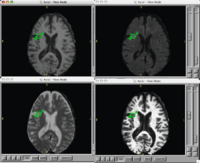Difference between revisions of "DBP2:MIND"
m (Update from Wiki) |
Tag: 2017 source edit |
||
| (57 intermediate revisions by 6 users not shown) | |||
| Line 1: | Line 1: | ||
| − | + | Back to [[DBP2:Main|NA-MIC DBP 2]] | |
| − | + | __NOTOC__ | |
| − | + | = Overview of MIND DBP 2 = | |
| − | + | == The Analysis of Brain Lesions in Neuropsychiatric Systemic Lupus Erythematosus == | |
| − | + | Critical to understanding the etiology of brain lesions in NPSLE will be the accurate measurement of their location, size, and time course. Lupus brain lesions are known to vary in MRI intensity and temporal evolution and include acute, chronic, and resolving cases. Monitoring the time course of image intensity changes in the vicinity of lesions, therefore, may serve to classify them based on their temporal characteristics. Hence, a major objective of this DBP will be the evaluation of existing tools and the development new tools within SLICER for the time series analysis of brain lesions in lupus. [[DBP2:MIND:Introduction|More...]] | |
| − | + | Data is provided at the following link: '''[[Data:DBP2:MIND|MIND Data]]'''. | |
| + | |||
| + | = MIND Roadmap Project = | ||
| + | |||
| + | {| cellpadding="10" border="1" style="background:lightblue;text-align:left;" | ||
| + | |||
| + | | style="width:15%" | [[Image:Lupus.png|200px]] | ||
| + | | style="width:85%" | | ||
| + | |||
| + | == [[DBP2:MIND:Roadmap|Brain Lesion Analysis in Neuropsychiatric Systemic Lupus Erythematosus]] == | ||
| + | |||
| + | Our goal is to automatically, or with little or no manual human rater input, accurately tissue classify our example lupus data-set into gray, white, csf, and lesion classes. [[DBP2:MIND:Roadmap|More...]] | ||
| + | |||
| + | |} | ||
Latest revision as of 07:07, 11 April 2023
Home < DBP2:MINDBack to NA-MIC DBP 2
Overview of MIND DBP 2
The Analysis of Brain Lesions in Neuropsychiatric Systemic Lupus Erythematosus
Critical to understanding the etiology of brain lesions in NPSLE will be the accurate measurement of their location, size, and time course. Lupus brain lesions are known to vary in MRI intensity and temporal evolution and include acute, chronic, and resolving cases. Monitoring the time course of image intensity changes in the vicinity of lesions, therefore, may serve to classify them based on their temporal characteristics. Hence, a major objective of this DBP will be the evaluation of existing tools and the development new tools within SLICER for the time series analysis of brain lesions in lupus. More...
Data is provided at the following link: MIND Data.
MIND Roadmap Project

|
Brain Lesion Analysis in Neuropsychiatric Systemic Lupus ErythematosusOur goal is to automatically, or with little or no manual human rater input, accurately tissue classify our example lupus data-set into gray, white, csf, and lesion classes. More... |